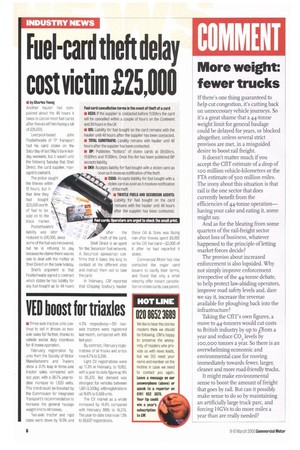More weight: fewer trucks
Page 8

If you've noticed an error in this article please click here to report it so we can fix it.
If there's one thing guaranteed to help cut congestion, it's cutting back on unnecessary vehicle journeys. So it's a great shame that a 44-tonne weight limit for general haulage could be delayed for years, or blocked altogether, unless several strict provisos are met, in a misguided desire to boost rail freight.
It doesn't matter much if you accept the CfIT estimate of a drop of roc) million vehicle-kilometres or the FTA estimate of 5oo million miles. The irony about this situation is that rail is the one sector that does currently benefit from the efficiencies of 44-tonne operation— having your cake and eating it, some might say.
And as for the bleating from some quarters of the rail-freight sector about loss of business, whatever happened to the principle of letting market forces decide?
The proviso about increased enforcement is also lopsided. Why not simply improve enforcement irrespective of the 44-tonne debate, to help protect law-abiding operators, improve road safety levels and, dare we say it, increase the revenue available for ploughing back into the infrastructure?
Taking the CfIT's own figures, a move to 44-tonners would cut costs to British industry by up to gam a year and reduce CO, levels by 100,000 tonnes a year. So there is an overwhelming economic and environmental case for moving immediately towards fewer, larger, deaner and more road-friendly trucks.
It might make environmental sense to boost the amount of freight that goes by rail. But can it possibly make sense to do so by maintaining an artificially large truck parc, and forcing HGVs to do more miles a year than are really needed?








































































































